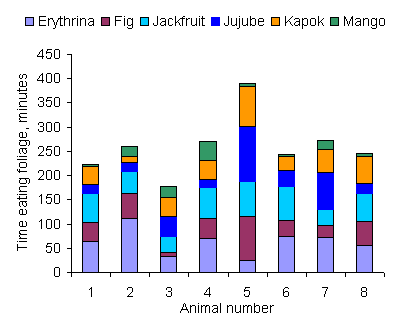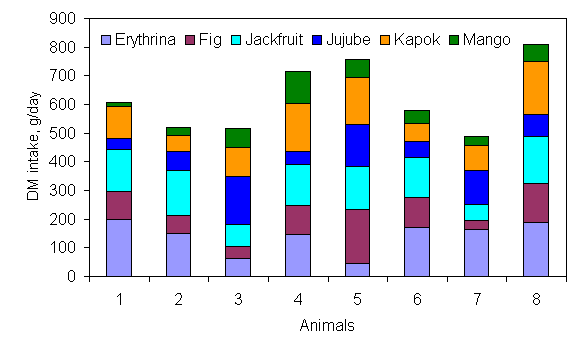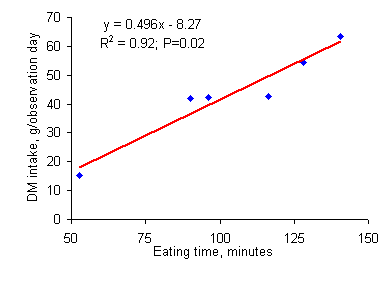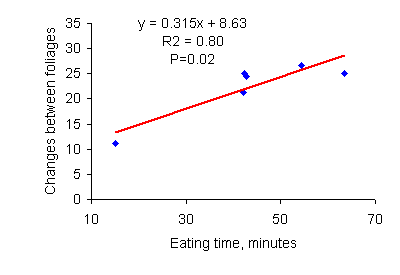Selective behaviour of goats offered different tropical foliages
Daovy Kongmanila, T R
Preston* and Inger Ledin**
Faculty of Agriculture,
National University of Laos, Vientiane Capital, Lao
PDR
* Finca Ecológica,
UTA-Colombia, AA #48, Socorro, Santander, Colombia
** Department of Animal Nutrition
and Management, Swedish University of Agricultural Sciences
P.O.
Box 7024, 750 07 Uppsala, Sweden
Abstract
Feed intake and selective behaviour of local goats offered different tropical foliage species were evaluated in a study using eight local male growing goats around 7 months old and weighing 15.7 (1.1) kg. The goats had free access to six foliage species: Erythrina (Erythrina variegata), Fig (Ficus racemosa), Jackfruit (Artocarpus heterophyllus), Jujube (Ziziphus jujuba Mill), Kapok (Ceiba pentandra) and Mango (Mangifera indica). The foliages were hung in separate bunches in a large pen with a total amount of 9 % of the body weight (BW) as dry matter (DM), 1.5 % of the BW of each foliage. The goats were fed 3 times per day at 08:00 h; 11:00 h and 14:00 h. The bunches of foliage were weighed before and after feeding to estimate feed intake from leaves plus petioles and stem of the different foliage species. The time spent eating each foliage in minutes was recorded during 9 hours per day from 08:00 h to 17:00 h for one goat per day in 8 days.
The average time spent
eating was 260 minutes, and the goats changed from one foliage to
another foliage 132 times. Feed intake was 634 g or 4.0% of BW and
eating rate 2.5 g per minute. There were large individual
differences between the goats in selective behaviour, feed intake
and eating rate. The mean time spent eating, number of selective
changes and total feed intake were higher for Erythrina, Jackfruit
and Kapok foliage than for Fig, Jujube and Mango foliage.
Keywords: Erythrina, Feed intake Fig,
Foliage, Goat, Jackfruit, Jujube, Kapok, Mango, Selective behaviour
Introduction
In the traditional feeding systems in tropical countries, the
native grasses, legumes and some foliages are the main feed
resources for ruminants. Foliages from trees and shrubs are
important feeds for grazing and browsing animals and often contain
appreciable amounts of nutrients that are deficient in other feed
resources (Komwihangilo et al 2001).
Goats have a habit of selecting their feed carefully when eating
and are considered to be agile feeders (Dumont et al 1995; Ngwa et al 2000). According to Steele (1996) goats are continuously
searching for feed and are more satisfied when they have a whole
range of different plants available including trees, shrubs and
grasses. The anatomical characteristics of goats, small mouths and
split upper lips, enable them to select even very small parts of a
plant. Goats are characterised as generalised feeders since they
adapt their choice according to what is available. However, goats
are also considered to be very fastidious and even when having a
very large selection to choose between they will only consume the
most nutritious feed available (Van Soest 1982; Fajemisin et al
1996).
Animal feeding behaviour has been the object of numerous studies
and there are a number of explanatory theories regarding the
principles of herbage selection by grazing animals (Dumont et al
1995). Knowledge of feeding behaviour is of fundamental importance
in management of pastures, especially with regard to the
determination of opportune feeding strategies and the type and
quantity of supplements to distribute (Claps et al
1997)
Steele (1996) reported that shoots and leaves are preferred to
stems when goats are allowed to select. Keskin et al. (2005) showed
that goats can spend 26.6 % of their time eating (383 minutes in 24
hours). There are many factors which are important for animal
selective behaviour, one of which is method of presentation of
feed. Van et al. (2005) suggested that the method of feeding by
hanging the foliages was the best way to improve feed intake and
eating rate of local goats fed Jackfruit (Artocarpus
heterophyllus), Flemingia (Flemingia macrophylla) and Acacia
(Acacia mangium) foliage. Pok Samkol (2003) also found the method of
hanging best when feeding Muntingia (Muntingia calabura) foliage.
The objective of the present study was to examine the feed
intake and selective behaviour of goats offered different tropical
foliage species.
Material and methods
The animals used in the experiment were 8 local male growing
goats. The goats were bought in the area around the Faculty of
Agriculture, Nabong campus, Vientiane, Lao PDR.
Foliage from Erythrina (Erythrina variegata), Fig (Ficus
racemosa), Jackfruit (Artocarpus heterophyllus), Jujube (Ziziphus
jujuba Mill), Kapok (Ceiba pentandra) and Mango (Mangifera indica)
was hung in separate bunches in a large pen. All foliages were
offered in the same amount, 1.5% of the BW as dry matter (DM) and
together offered in a total amount of 9 % of the BW. The goats were
fed 3 times per day at 08:00 h, 11:00 h and 14:00 h. One goat was
let in to the pen every morning and the feeding behaviour was
recorded as the time spent consuming each foliage during the day
from 08:00 h to 17:00 h. The foliages offered were separated and
weighed to estimate the average proportion of leaves plus petioles
and stems four times during the experiment and the refusals were
also separated into leaves plus petioles and stem every day after
feeding. The bunches of foliage were weighed before and after
feeding to estimate feed intake from leaves plus petioles and stem
of the different species. Fresh bunches of feed and a new goat was
provided every day and the procedure was repeated for 8
days.
The data from the preference test is presented in the form of
frequencies and means using the Excel program.
Results
Time spent selecting different foliage species
The time spent eating during the observation day varied between
178 and 390 minutes, with an average and SD of 260 (60.8) minutes
(Figure 1). On average 48 (11.3) % of the observation day of 9
hours was spent eating. There was also a large variation in time
spent eating the different foliages e.g. for Mango from 3 minutes
to 38 minutes and for Jujube from 17 minutes to 114 minutes. More
time was in general spent on Erythrina, Jackfruit and Kapok than on
Fig, Jujube and Mango.
|
|
|
|
Figure 1. Time in minutes spent eating each foliage during the
observation |
Figure 2. The number of times per day the animals changed from
one foliage to another |
The number of times per observation day the animals
changed from one foliage to another ranged from 83 to 207 times
(Figure 2) with an average of 132 (47.7) times per day. In Figure
3 is an example of how many minutes were spent on each foliage. The
figure shows animal number 1, the animal with the lowest number of
changes and quite short eating time. Animal number 1 spent close to
4 hours eating during the 9 hours of observation compared to animal
5, that spent 6.5 hours. Animal number 1 selected the Mango
foliage only twice and 3 minutes were spent eating the Mango
foliage while Erythrina, Fig, Jackfruit and Kapok were selected 14
to 22 times.
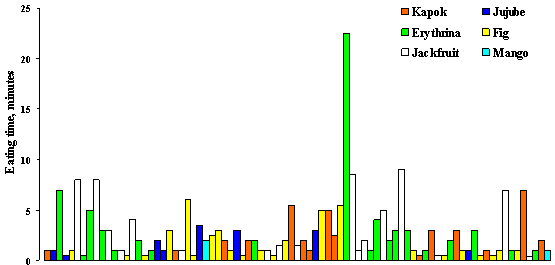
|
|
Figure 3. Time spent in minutes and order when
selecting the different foliage species during one |
Intake of the different foliages species
The intake of the different foliage species for each animal is
presented in Figure 4. The highest DM intake was 809 g/day and the
lowest 487 g/day with a mean of 624g per day. The total
intake was on average 4.0% of BW. The DM intake of the
different foliage species ranged from 53 g in the Mango foliage to
141 g in the Erythrina foliage (Figure 5). The DM intake of the different
foliages, expressed
in percent of BW, varied from 0.3% to 0.9 %, with the
lowest value for Mango foliage and highest for Erythrina.
|
|
|
Figure 4. Intake of different foliages by
individual goats, g DM/observation day (9
h) |

Figure 5. Intake of different foliages, g DM/observation day (9
h)
The intake of stem (Figure 6) was highest in Jackfruit and lowest in Mango.

Figure 6. Intake of leaves, petioles and stem of the different
foliages, g DM/observation day
Relation between intake and eating time, and eating time and number of changes from one species to another
The total DM intake (Figure 7) was significantly related to
eating time (P=0.002, R2=0.93); the longer the eating
time the higher the feed intake. The number of changes from one
species to another (Figure 8) was also significantly related to the
eating time (P=0.002, R2=0.80); the longer the eating
time the higher the number of changes from one foliage to another.
|
|
|
|
Figure 7 The relation between DM intake, g and eating time,
minutes |
Figure 8. The relation between eating time, minutes and number
of changes between foliages |
Discussion
Time spent selecting different foliage species
The total time spent eating throughout the observation day
ranged from 178 to 390 minutes. Kouch (2003) found that the eating
time was 308 min in 24 h; Keskin et al. (2005) reported an eating
time of 383 minutes in 24 h and Van et al. (2005), 255 minutes in
24 h. The average time spent eating in the present study was 48 %
of the 9 observation hours, higher than Kouch (2003), Samkol (2003)
and Keskin et al. (2005), who recorded 21.4 % of 24 h, 35.2 % of 10
h and 26.6 % of 24 hours, respectively. The difference is probably
due to the fact that the goats eat mostly during the daytime (Van et al 2005) while they ruminate or sleep in the night time. The
period used for recording eating time will thus affect the
proportion of time used for eating.
The goats spent most of their eating time on Erythrina,
Jackfruit and Kapok, foliages, obviously having the best intake
characteristics of the six foliages compared. These three foliages
also had the highest crude protein content and digestibility (Kongmanila Daovy
et al 2007b) which confirms the opinion of several authors that goats choose
and consume the most nutritious feed available (Van Soest 1982; Fajemisin et al 1996). However, the goats also spent quite a long
time (114 minutes, more than 40% of the total eating time) on the
lower quality foliages. Even though intake of e.g. Jujube was not
very high it has been shown that the foliages from the
Ziziphus family are preferred by goats (Ngwa et al 2000).
The number of times the goats changed from one foliage to
another, and total time spent eating, ranged from 83 to 207 times
and 4.0 to 6.5 h, respectively. It seems that eating time and way
of selection are highly individual characteristics and can vary
within quite a wide range. This has also been noted by among others
Morand-Fehr et al. (1991) and Abijaoude et al. (2000), who found
that the eating time of goats varied between 4 h and 9 h per
day.
In general the behaviour study confirmed earlier studies that
goats prefer to select and consume many different types of foliage
every day (Sanon et al 2007) and will do so even if the nutrient
quality of some of the foliages is not high.
Intake of the different foliage species
The mean DM intake per observation day was lower, 624 g and 4.0%
of BW, compared to the 4.2% to 4.8% of BW obtained by Kouch (2003)
and Van et al. (2005), respectively, when using the hanging method
feeding Jackfruit, Mulberry and Cassava foliage. Hanging seems to
be the best way to improve feed intake and eating rate of goats,
especially when the foliages have low intake characteristics
(Kouch, 2003; Samkol, 2003; Van et al 2005; Phengvilaysouk and
Kaensombath, 2006), although intake will also depend on foliage
species available. When the goats have many species to choose
between they will obviously not only select the foliages with the
best quality but also eat small amounts of other foliages, as
discussed above, and this will result in lower intake. In the case
of Van et al. (2005) Jackfruit was the only foliage available. The
low DM intake of Mango foliage, 53 g or 0.3% of BW, compared to the
other foliages, is probably due to the structure of the leaves. The
leaves of Mango are hard and have a high DM content and the goats
preferred the petioles to the leaves and stems of Mango. The
Erythrina foliage had a soft and smooth structure in all parts
(leaves, petioles and stem) and this could have contributed to the
higher intake of Erythrina, as also suggested by Aregheore and
Perera (2004).
The proportion of leaves plus petioles and stem of foliage can
also have affected the intake. Fig, Jujube and Mango foliages had a
higher percentage of stem with a hard structure compared to
Erythrina, Jackfruit and Kapok foliages. The highest feed intake
was from the three foliages which had a high proportion of leaves
plus petioles. Goats generally prefer to select shoots, leaves and
stem in that order (Steele, 1996).
Relation between intake and eating time and eating time and number of changes from one species to another
There was a close relation between total DM intake and eating
time, and also eating time and number times the goats changed
foliage species, respectively. This resulted in a mean eating rate,
of 2.5 g per minute compared to 1.1 g per minute obtained by Samkol
(2003) and 3.5 g per minute recorded by Kouch (2003). Differences
in eating rate can be due to individual characteristics as well as
type of feed and methods of presenting the feed.
Conclusions
-
The mean time spent eating and selecting, the number of selective changes and the total DM intake of goats were higher when fed Erythrina, Jackfruit and Kapok foliage compared to Fig, Jujube and Mango foliage.
-
However, there were large individual differences concerning preferred foliage species, eating rate and selective behaviour.
-
Of the foliage species studied, Erythrina especially, but also Kapok, seem to be interesting species, on which little research, at least when used as a feed for goats, has been done.
Acknowledgements
The authors would like to acknowledge the Swedish International
Development Agency/Department for Research Cooperation with
Developing Countries (Sida/SAREC) for funding this study. Thanks
are also due to the Faculty of Agriculture, National University of
Laos for making the facilities available and the four students of
HD3 (12th Generations) in this institution
for the help in the data collection.
References
Abijaoude J A, Morand-Fehr P, Tessier J, Schmidely P and
Sauvant D 2000 Diet effect on the
Ammaly Phengvilaysouk and Lampheuy Kaensombath 2006:
Effect on intake and digestibility by goats given jackfruit
(Artocarpus heterophyllus) leaves alone, the whole branch or
free access to both. Livestock Research for Rural Development.
Volume 18, Article #38. Retrieved June 8, 2007, from http://www.cipav.org.co/lrrd/lrrd18/3/amma18038.htm
Aregheore E M and Perera D 2004 Effects of Erythrina
variegata, Gliricidia sepium and
Leucaena
leucocephala on dry matter intake and nutrient
digestibility of maize stover, before and after spraying with
molasses. Animal Feed Science and Technology 111, 191-201.
Clips S, Rubino R and Fedele V 1997 Feeding behaviour of
grazing and zero-grazing goats fed with
DumontB, Meuret M and Prud'hon M 1995 Direct
observation of biting for studying grazing
Fajemisin B, Ganskopp D, Cruz R and Vavra M 1996
Potential for woody plant control by Spanish
Keskin M, Sahin A, Bicer O, Gul S, Kaya S, Sari A and Duru M
2005 Feeding Behaviour of
Komwihangilo D M, Sendalo D S C, Lekule F P, Mtenga L A and
Temu V K 2001 Farmers'
Kouch T, Preston T R and Ly J 2003
Studies on feeding
behaviour in goats fed tree foliages. MSc
Morand-Fehr P, Owen E and Giger-Reverdin S 1991 Feeding
Behaviour of goats at the trough.
Ngwa A T, Pone D K and Mamen J M 2000 Feed selection and
dietary preferences of forage by
Pok Samkol 2003: Effect of method
of offering Muntingia (Muntingia calabura) foliages to
goats on intake and feeding behaviour; Retrieved June 8, 2007,
from MEKARN Mini-projects.
http://www.mekarn.org/msc2003-05/miniprojects/web
page/samkol.htm
Sanon H O, Kabore-Zoungrana C and Ledin I 2007 Behaviour
of goats, sheep and cattle and their
Steele M 1996 Goats. The Tropical Agriculturalist.
Macmillan Education, Between Towns Road,
Theng Kouch, T R Preston and J Ly 2003: Studies on utilization of trees and shrubs as the sole feedstuff by growing goats; foliage preferences and nutrient utilization. Livestock Research for Rural Development 15 (7). http://www.cipav.org.co/lrrd/lrrd15/7/kouc157.htm
Van D T T, Mui N T and Ledin I 2005 Tropical foliages:
effect of presentation method and species on
Van Soest P J 1982 Nutritional ecology of the ruminant. O and B Books, Corvallis, Oregon.
